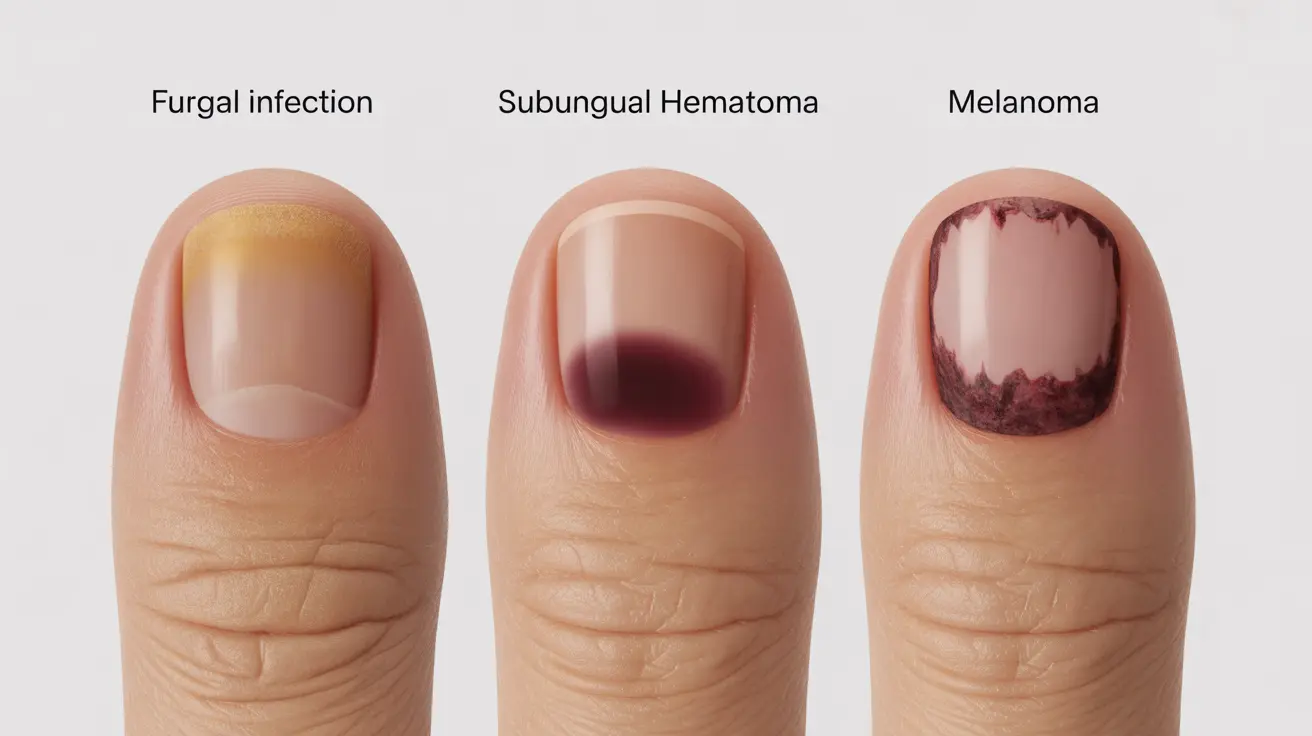When you notice a dark spot or discoloration under your toenail, it's natural to feel concerned. While most cases are benign, understanding the differences between toenail fungus, subungual hematoma, and toenail melanoma is crucial for proper diagnosis and treatment. Each condition has distinct characteristics that can help identify the underlying cause of toenail changes.
This comprehensive guide will help you understand the key differences between these conditions, their warning signs, and when to seek medical attention. Remember that while self-assessment is helpful, professional medical evaluation is essential for accurate diagnosis.
Key Characteristics of Toenail Conditions
Toenail Fungus (Onychomycosis)
Fungal nail infections are the most common cause of toenail discoloration. They typically present with:
- Yellowing or browning of the nail
- Thickened, brittle, or crumbly nail texture
- Distorted nail shape
- Separation of the nail from the nail bed
- Debris buildup under the nail
Subungual Hematoma
A hematoma under the nail usually occurs after trauma and shows these features:
- Reddish-purple or black coloration
- Clear relationship to injury
- Pain or tenderness, especially initially
- Distinct borders of discoloration
- Color changes that grow out with the nail
Toenail Melanoma
Subungual melanoma, though rare, requires immediate attention when suspected. Watch for:
- Dark brown or black streak in the nail
- Irregular borders or color variations
- Pigmentation that extends into the surrounding skin
- Progressive darkening or spreading
- No history of trauma
- Single nail involvement
Important Visual Differences
Color and Pattern
The color and pattern of nail discoloration can provide important clues:
- Fungal infections typically appear yellow-brown and affect multiple nails
- Hematomas are usually purple-black with well-defined edges
- Melanomas often present as dark brown or black streaks with irregular patterns
Growth and Progression
Observing how the condition changes over time is crucial:
- Fungal infections spread gradually and may affect multiple nails
- Hematomas grow out with the nail and eventually disappear
- Melanomas typically worsen over time and may affect the surrounding skin
When to Seek Medical Attention
Immediate medical evaluation is recommended if you notice:
- A new dark streak in the nail with no apparent cause
- Changes in an existing nail streak
- Nail changes that don't improve or worsen over time
- Pain or inflammation around the nail
- Any concerning changes in nail appearance
Diagnostic Procedures
Healthcare providers may use several methods to determine the exact cause:
- Physical examination and medical history
- Nail biopsy if melanoma is suspected
- Fungal culture for suspected infections
- Dermoscopy for detailed nail examination
- Medical imaging in some cases
Frequently Asked Questions
How can I tell the difference between a toenail fungus, a subungual hematoma, and toenail melanoma?
Fungal infections typically appear yellow-brown and affect multiple nails with thickening and brittleness. Hematomas are usually purple-black, appear after injury, and grow out with the nail. Melanomas often present as dark brown or black streaks with irregular borders and may affect the surrounding skin.
What are the warning signs of melanoma under the toenail compared to a fungal nail infection?
Melanoma typically appears as a dark streak with irregular borders and may spread to surrounding skin. Fungal infections usually cause yellowing, thickening, and brittleness of the nail, often affecting multiple toes. Melanoma typically affects a single nail and progressively worsens.
Can a dark spot under my toenail be a melanoma even if I have no history of trauma?
Yes, melanoma can develop without any previous injury. In fact, the absence of trauma history with a new dark streak under the nail should raise concern and prompt medical evaluation.
When should I see a doctor to evaluate discoloration or changes in my toenail?
Seek medical attention if you notice a new dark streak, changes in an existing streak, worsening symptoms, pain, inflammation, or any concerning changes that don't improve over time.
What diagnostic tests are used to distinguish subungual melanoma from fungal infections or hematomas?
Doctors typically use physical examination, dermoscopy, nail biopsies (for suspected melanoma), fungal cultures (for suspected infections), and sometimes medical imaging to make an accurate diagnosis.




